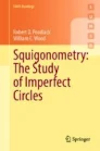- About MAA
- Membership
- MAA Publications
- Periodicals
- Blogs
- MAA Book Series
- MAA Press (an imprint of the AMS)
- MAA Notes
- MAA Reviews
- Mathematical Communication
- Information for Libraries
- Author Resources
- Advertise with MAA
- Meetings
- Competitions
- Programs
- Communities
- MAA Sections
- SIGMAA
- MAA Connect
- Students
- MAA Awards
- Awards Booklets
- Writing Awards
- Teaching Awards
- Service Awards
- Research Awards
- Lecture Awards
- Putnam Competition Individual and Team Winners
- D. E. Shaw Group AMC 8 Awards & Certificates
- Maryam Mirzakhani AMC 10 A Awards & Certificates
- Two Sigma AMC 10 B Awards & Certificates
- Jane Street AMC 12 A Awards & Certificates
- Akamai AMC 12 B Awards & Certificates
- High School Teachers
- News
You are here
Squigonometry: The Study of Imperfect Circles

Publisher:
Springer
Publication Date:
2022
Number of Pages:
308
Format:
Paperback
Series:
Springer Undergraduate Mathematics Series
Price:
37.99
ISBN:
978-3031137822
Category:
Textbook
[Reviewed by , on ]
Frederic Morneau-Guérin
08/27/2023
Certain books, due to the originality of the subject covered or the approach adopted, are unclassifiable. Squigonometry: The Study of Imperfect Circles certainly falls into this category. This singular work was born from the meeting of two mathematicians – Robert D. Poodiack, a professor at Norwich University, Vermont and William E. Wood, a professor at the University of Northern Iowa – both of whom had previously published research articles on squigonometry, generalized trigonometry arising from the study of the p-unit circle
\( | x |^{p}+ |y|^{p}=1 \)p
for \( p \geq 1 \) and \( p \neq 2 \) in the same way that usual trigonometric functions arise naturally from the study of the curve of equation \( x^{2} + y^{2}=1 \). Thinking that a collaborative article would not allow them to exhaust the list of interesting themes related to their subject of shared interest, they decided to work together to write a monograph. The resulting book stands out due to its innovative character, the appealing nature of its subject and how clearly it is expressed and explained.
Squigonometry offers a modern perspective on certain types of older mathematical knowledge. This book is intended as an introduction to generalizations of concepts that students get a glimpse of starting in high school, namely:
- The unit circle as the set of points that are a (Euclidean) distance of 1 unit from the origin;
- The unit circle as the locus of points \( (x, y) \) related by the equation \( x^{2} + y^{2}=1 \);
- The fundamental Pythagorean trigonometric identity \( \sin^{2}(\theta) + \cos^{2}(\theta) =1 \);
- 4. The number \( \pi \).
In this monograph, the authors have compiled results about variants of sine and cosine functions that can parameterize the closed curve \( |x|^{p}+|y|^{p}=1\) that had been known for many years, as well as others that have been obtained recently (sometimes by the authors themselves). First, fundamental results concerning generalized trigonometric functions are addressed, such as relational equations (squigonometric identities), derivatives, series approximations and integrals. Next, derivative subjects are explored, such as hyperbolic, exponential and logarithmic functions and the generalization of \( \pi \) for each \( p \), as well as more advanced and specialized subjects such as lemniscate elliptic functions.
Divided into 20 short single-theme chapters totaling more than 230 pages, this colorful book features around a hundred figures. Each chapter begins with a brief introduction presenting the history of the subject addressed, then presents the main results as well as proofs for them. There are also 6 appendices totaling 45 pages. There are 108 graphs illustrating various phenomena that are arranged based on the value of \( p \) chosen as well as a compilation of formulas presented or referenced in the text. Lastly, the final pages of the book contain a bibliography combining more than 100 references as well as a thematic index.
The level of difficulty of the exercises presented at the end of each chapter (around 150 in all) varies significantly. Nevertheless, the notions and results needed to resolve them can be found in the text. A few clues and some solutions for these exercises are presented in the appendices.
Readers are expected to be familiar with trigonometric functions, have mastered the basics of single-variable differential and integral calculus, know how to resolve initial value problems and be familiar with the main elementary results concerning infinite series, but no more advanced knowledge is required. The book will therefore be suitable both in the context of an undergraduate mathematics course with directed reading and for end-of-undergraduate study research projects. Incidentally, 25 descriptions of projects intended to serve as a springboard for independent study are included throughout the book. It should be noted that some of them could very likely be extended into full research projects likely to lead to new discoveries.
Frederic Morneau-Guerin is a professor in the Department of Education at Universite TELUQ. He holds a Ph.D. in abstract harmonic analysis.
See the publisher's website.
- Log in to post comments




